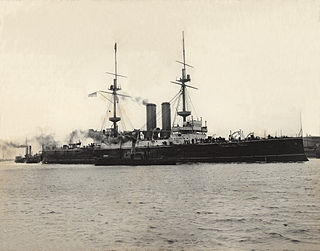
The Home Fleet was a fleet of the Royal Navy that operated from the United Kingdom's territorial waters from 1902 with intervals until 1967.

The British Mediterranean Fleet, also known as the Mediterranean Station, was a formation of the Royal Navy. The Fleet was one of the most prestigious commands in the navy for the majority of its history, defending the vital sea link between the United Kingdom and the majority of the British Empire in the Eastern Hemisphere. The first Commander-in-Chief for the Mediterranean Fleet was the appointment of General at Sea Robert Blake in September 1654. The Fleet was in existence until 1967.

The Atlantic Fleet was a naval fleet of the Royal Navy. It existed for two separate periods; 1909 until 1914, and then 1919 until 1932.

The Fifth Sea Lord was formerly one of the Naval Lords and members of the Board of Admiralty that controlled the Royal Navy. The post's incumbent had responsibility for naval aviation.

The Channel Fleet and originally known as the Channel Squadron was the Royal Navy formation of warships that defended the waters of the English Channel from 1854 to 1909 and 1914 to 1915.

The First Cruiser Squadron was a Royal Navy squadron of cruisers that saw service as part of the Grand Fleet during the World War I then later as part of the Mediterranean during the Interwar period and World War II it first established in 1904 and existed until 1952.

The Assistant Chief of the Naval Staff (A.C.N.S.) is a senior appointment in the Royal Navy usually a two-star rank and has a NATO ranking code of OF-7.

The Assistant Chief of the Naval Staff formerly the Assistant Chief of the Naval Staff is a senior Royal Navy appointment responsible for naval aviation. The post is also the successor to the Royal Navy's Flag Officer for naval aviation in the British Isles, established since 1939.

The Department of the Director of Naval Equipment also known as the Directorate of Naval Equipment was the former British Admiralty department responsible for managing the progress of all naval construction at royal naval dockyards, and annually planning programmes of works for additions, alterations, repairs and modernisation established in 1912 until 1960 when it was replaced by the Naval Equipment Division of the Ship Department.

The 7th Battle Squadron was a squadron of the British Royal Navy assembled prior to World War I it was assigned to the Third Fleet and consisted of pre-dreadnought type battleships the oldest ships in fleet it existed from 1912 to 1914.

The Training and Staff Duties Division and later known as the Tactical and Staff Duties Division was a directorate of the Admiralty Naval Staff of the Royal Navy responsible for the tactical use of naval weapons and the training of naval personnel in relation to operational requirements from 1917 to 1958.

The Admiral Commanding, Reserves was a senior Royal Navy post that existed from 1875 to 1976.

The Flag Officer, Royal Yachts, (FORY) also styled Flag Officer Commanding Royal Yachts was a senior Royal Navy post that existed from 1884 to 1997.

Flag Officer, Carriers and Amphibious Ships (FOCAS) was a senior Royal Navy post that existed from 1931 to 1979.

The 2nd Cruiser Squadron was a formation of cruisers of the British Royal Navy from 1904 to 1919 and from 1921 to 1941 and again from 1946 to 1952.

The Flag Officer, Flying Training, later called Flag Officer Naval Flying Training, was a senior Royal Navy appointment responsible for all naval aviation flying training from 1945 to 1970.

The Flag Officer, Ground Training was a senior Royal Navy appointment responsible for all naval aviation ground training from 1949 to 1957.

The Flag Officer, Third Flotilla was the senior Royal Navy appointment in command of the Third Flotilla from 1979 to 1992.

The Directorate of Navigation and Tactical Control (Naval) was a directorate of the Navy Department, Naval Staff first established in 1912 as the Navigation Department of Hydrographic Department of the Admiralty. In 1945 it was renamed the Navigation Division and assigned to the Admiralty Naval Staff. In 1946 it was re designated Navigation and Direction Division until 1966 and now part of the Navy Department Naval Staff it was renamed the Directorate of Navigation and Tactical Control (Naval). The staff directorate was administered by the Director Navigation Tactical Control (Naval) who reported to the Assistant Chief of the Naval Staff (Warfare) it existed until 1968.








